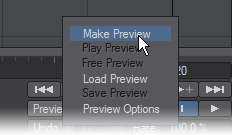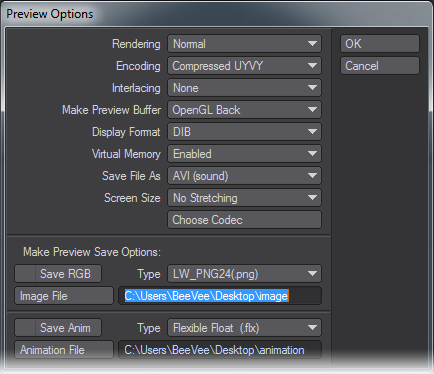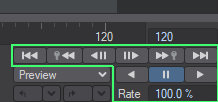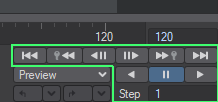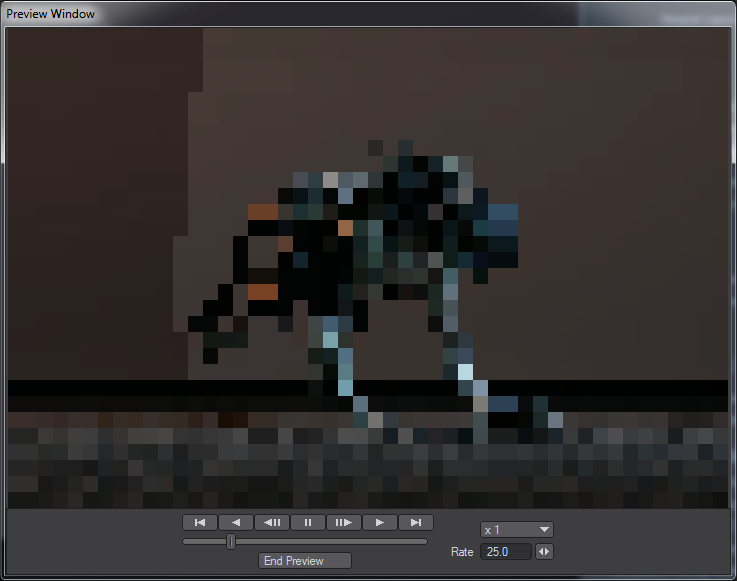Previsualization
Introduction
There will be times, more often than not, when you will want to plan out your animations or review your progress as you are working without doing a full render. This is the role of previsualization, or previz.
Creating a Preview Animation
In addition to playing a scene using the transport controls, you can also create special preview animations. In most cases, these will give you a more accurate preview of your final animation.
To Create a Preview Animation:
- If you are using multiple viewports, you will be asked which you wish to use. You can indicate the viewport for the preview by clicking the small camera icon that appears when you have multiple viewports.
- Make sure the viewport’s Maximum Render Level is set as desired. If you would like a full-rendered preview, set the viewport to VPR (there are other options if you do so).
- Select Make Preview from the Preview pop-up menu. A dialog will appear asking you for first and last frame settings, as well as Step. This initially defaults to the scene settings, but may be set independently. Click OK and the preview animation will be created.
- When the preview is complete, the Preview Playback Controls Panel will appear.
You can press the Esc key to stop creating the preview animation. The animation will still be playable up to the point of termination.
Here’s a rundown of the Preview Playback Controls:
01 Go to the end of playback, 02 Step, 03 Pause, 04 Play, 05 Multiplier, 06 Slider, 07 End Preview, 08 Playback rate
To save time creating a preview animation for a complex scene, do the Texas Two Step: use a Step of 2 and playback using a frame rate one-half the desired rate.
Preview Options
Also from the Preview pop-up menu, you can replay the preview currently in memory, free it from memory, and load/save a preview animation file. Selecting Preview Options from the Preview pop-up menu will display a dialog.
Here, you can select a compression level for preview animations, as well as select the format and codec used when you save them. Compressed previews use much less memory, thus you can have a lot more frames before virtual memory starts being used, which bogs down playback.
Compressed preview files are also smaller when saved to disk. You can also set whether or not to use virtual memory for preview animations.
Using the Make Preview Buffer option, you can choose to record the OpenGL back (offscreen) or front (on screen) display buffer. Other options may be available (e.g., Direct Draw). You may get better performance with different settings, depending on your video card.
When Virtual Memory is set to Disabled, LightWave attempts to use only RAM for storage and playback. (Your operating system can still ultimately swap the data to virtual memory, however.)Setting Screen Size to Stretch to Fit causes the image to fit the window, even if it is a different size than what was used when the preview was made.
You will want to install additional codecs, especially on Windows systems. The only codecs built into Windows tend to be very old. Consider XViD, QuickTime and Lagarith codecs.
Layout Transport Controls
You can use the transport controls to navigate through your scene.
The controls are symmetrical forwards and backward. They are Go to Start, Go to Previous/Next Key, Frame Step and Play/Pause. The Rate/ Step field allows speed of playback control.
Keyboard Shortcuts
There are also some keyboard shortcuts that can be used:
- Previous frame Left
- Next frame Right
- Previous keyframe Shift + Left
- Next keyframe Shift + Right
- Play Backwards Page Down
- Pause Insert
- Play Forwards Page Up
Going to a Specific Frame
If you press the F key, a dialog will appear. Enter the frame you want to go to.
Playing the Scene
You can also play your scene backward (left arrow) or forward (right arrow) from the current frame using the playback controls. The Step field, in the bottom-right corner, determines the frame increment. A setting of 1 will play all frames; 2 will play every other frame, and so on.
Your playback speed will vary depending on the complexity of your scene, object display mode, system capabilities and so on. Reducing the size of your Layout window can dramatically increase playback speed.
VPR (Viewport Preview Renderer)
VPR is Layout’s native Interactive Render. Essentially, VPR is the LightWave renderer in a next gen interactive form. The VPR Interactive Renderer handles Radiosity, Ray-Tracing, Reflections, Refractions, and Transparencies - pretty much anything in short - to provide stunning LightWave renders as quickly as possible. VPR is activated in the Viewport Display menu by selecting VPR instead of one of the standard OpenGL view types. Once activated the viewport will begin rendering using the settings in the Render Globals panel. VPR will continually update when changes are made. VPR is explained in full starting page PDF_LINK.
Creating a VPR Preview
While VPR is running, you can create previews just as with any other viewport display mode. You also have the choice of either making the preview in a viewport or as a separate window. To do so, visit the Display Options tab of the Preferences window (D) and check Undock Preview Win. You can also choose to use the Camera Resolution, but beware with this that your camera resolution isn’t bigger than your screen resolution (you can hit Esc to leave the window).
The last option is to set the Preview Scale Level. This setting applies whether you undock the Preview window or create a preview in a viewport and offers a dropdown with a choice of Antialiased at the top down to Every 32 pixels at the bottom. Obviously, the lower the resolution, the faster the preview will render. It’s up to you to determine what level of detail you require from your preview.
